
The 21 Social Media Conversations You’re Going to Face: How to Master Them All
Head of Content at Buffer
On social media—whether you’re a business, a brand, or an individual—you’ll likely come across plenty of different conversations — each presenting a unique challenge. For instance:
How do you appease an angry commenter?
How do you handle a technical question?
What to do with a troll?
It can feel overwhelming.
If you take a step back and examine the emotions and psychology in play during each conversation, things can become a lot clearer and you can start to formulate your replies in a more timely and understanding manner.
We’d love to offer up some templates and tips on how to respond to 21 unique conversations you’re likely to face on social media.
Let’s get started!
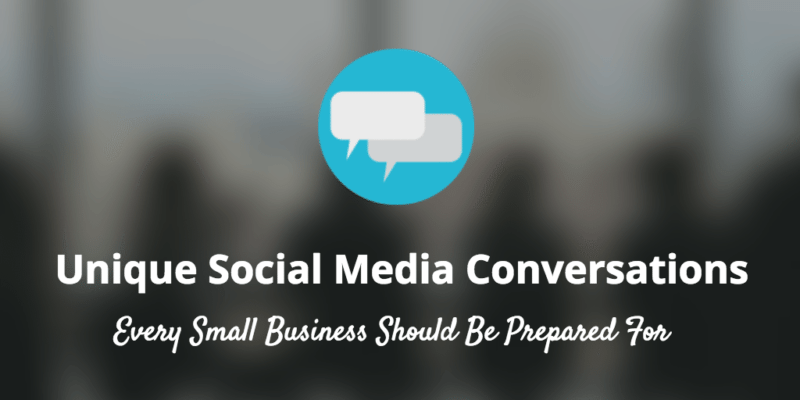
1. Responding to a question

This is probably one of the most common conversations you’ll come across in your day-to-day business. Oftentimes, questions will be focused around practical topics like how to use a product or what advice you have for others in your niche, but it’s also worth being prepared for conversations around personal info, company vision, culture and the team.
The emotion behind the conversation: Inquisitive, confused. ?
How to respond
- Acknowledge the question: Even if you’re unable to answer right away, you should acknowledge the question and reply — a holding message can go a long way to keeping a customer satisfied and helps them to know they’ve been heard.
- Get an answer ASAP: If you can answer right away, perfect! If not — maybe you need some assistance from another area of the business or time to do some research— try to ensure you can get a reply to the customer as soon as you possibly can.
How we respond at Buffer: It can be best to reply to every question you receive. It’s great to build relationships with customers by engaging with their questions and by answering a question you could help alleviate customer service messages further down the line.
2. Welcoming a new follow

A new follow is a great chance to start a conversation and build a relationship, especially if your new follower is particularly interesting or influential.
The emotion behind the conversation: Interested, enthusiastic ?
How to respond
- Welcome: A nice, warm welcome can be the perfect way to kick things off with a new follower. Take a quick peek at their profile and see if you can find some common ground to discuss.
How we respond at Buffer: It’s not really essential to reach out and welcome every new follow. A good approach could be to do this sparingly, saving it for any new followers who particularly pique your interest.
3. Acknowledging a reply

The reply is a staple of almost every social media platform. When someone decides to reply to one your posts, here’s how to deal with it.
The emotion behind the conversation Interest ?
How to respond
- Acknowledge the reply: Sometimes it can be nice to favorite or like a reply as a way to acknowledge it’s been seen, even if you don’t directly reply.
How we respond at Buffer: Conversations usually come to a natural end point and not every reply will need a response.
4. Accepting someone’s thanks

Thank you is a polite way to express gratitude. When someone reaches out to you to say thanks, a gracious acknowledgement of their thanks is usually what’s required.
The emotion behind the conversation Gratefulness, enthusiasm ?
How to respond
- Show gratitude: When someone reaches out to say “Thank you,” it’s great to be humble and show gratitude in your reply. Something like, “Really appreciate you taking the time to check out our post!” could be a great way to respond to someone who reaches out to thank you.
How we respond at Buffer: Not every thank you will need a reply, especially if there’s a high volume (what an awesome position to be in!). A Favorite or Like can go a long way here too.
5. Bypassing trolls
Trolls have become infamous online. A troll is someone who may try to start arguments by posting in off-topic messages in an online community.
The emotion behind the conversation: Troublesome, non-serious ?
How to respond
- Be careful: Trolls are often looking for a rise out of you and a response can sometimes play into there hands.
How we respond at Buffer: Most of the time, trolls are best left ignored — respond only when it makes sense to.
6. Replying to an angry customer
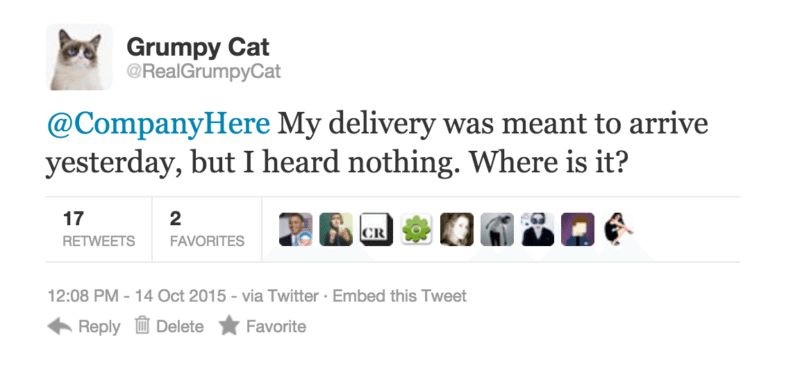
Eventually a customer will disagree with you on social media. It’s bound to happen. Here’s how to deal with it.
The emotion behind the conversation: Anger, disappointment ?
How to respond
- Reply as soon as possible: 42% of customers expect a reply in under 60 minutes on social media, so speed is super-important here. Even if you can’t solve the problem right away, simply letting the customer know they’ve been heard goes a long way.
- Find the root cause: Most people won’t default to angry right away, if you’re receiving an angry message it’s likely the issue has rolled on for a while. Getting to the bottom of the cause could go some way to figuring out a solution. At Buffer we turn to a simple but remarkably effective process for this: The 5 Whys.
How we respond at Buffer: These cases can be sensitive. As well as replying as soon as possible, it’s awesome to reply to every angry customer on social media.
7. Thanking someone who shares your content
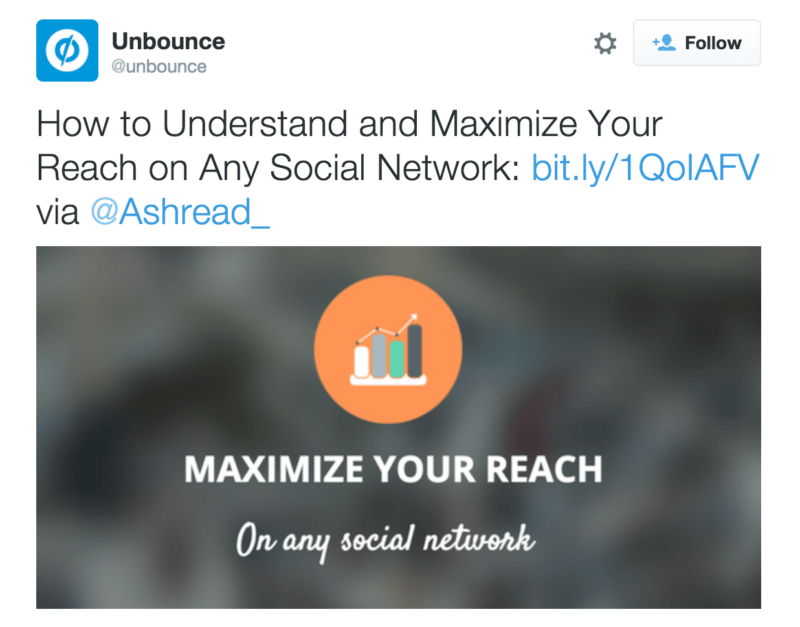
In marketing, there are few better feelings than people sharing your content.
The emotions behind the conversation: Appreciative, thankful. ?
How to respond
- Show gratitude: It feels amazing to have your content shared. I like to always show gratitude and say thanks within my reply.
- Leave the conversations open: It can be great to leave conversations open in this situation. Try to invite a reply without demanding one, for example: “Thanks so much for sharing. Did you find these tips useful?”
How we respond at Buffer: It can be very time consuming to respond to everyone who shares your content – especially if it’s highly shared. But showing a willingness to reply to a number of people who share goes a long way.
8. Welcoming someone who says “hi”

On social media, sometimes people just like to say ‘hi’ and get a conversation started.
The emotion behind the conversation: Curious. ?
How to respond
- How can we help?: As a community manager, I usually like to respond to these types of messages with a simple question: “How can we help?” This allows the conversation to evolve and can lead into a more rewarding exchange for both your business and the customer.
How we respond at Buffer: It really depends on volume with this one. If you’re getting a couple of messages per day, you could reply to every one. If you’re receiving hundreds or thousands, then it could be fine to reply to just a few.
9. Listening to a technical question

These ones can be a little tricky, especially if you’re a non-technical community manager. It’s important to have an escalation process in place for conversations like these, so that you know where you can go to get an answer.
The emotion behind the conversation: Curious, interested ?
How to respond
- Let them know they’re heard: As with the angry customer, these questions can’t always be fully resolved in-the-moment. If you can’t answer right away, try to reply with a holding message to let them know you’re looking into it.
- Pass on to a technical person: If you can’t answer this type of question yourself, it’s best to pass it onto a technical person who can help out. At Buffer, if a technical question pops up, we tend to share it with our engineers via email or Hipchat to figure out an answer.
How we respond at Buffer: Responding to every question here could be a great approach. It shows a willingness to go above and beyond for the customer and also provide an opportunity to show a human side (and that you’re not simply responding to everyone using canned responses).
10. Assisting a disappointed customer with a refund

No matter how great your product is, at some stage or another, you’ll have to deal with a return or refund over social media and it’s vital to get this right.
The emotion behind the conversation: Disappointment. ?
How to respond
- Be polite and respectful: When someone asks for a refund, it’s an opportunity to provide them with a great experience and learn about your business. Listening to why someone is looking for a refund can give you amazingly useful insights into your product or service and your marketing. If you treat them with respect and talk politely, you could learn a ton that’ll help you keep more customers on-board in the future.
- Avoid being defensive: When you pour your heart and soul into business, it can be hard not to take a refund request personally and reply defensively. A better option could be to embrace vulnerability and act without your heart on your sleeve – try to be thankful they kicked the tires a bit and understand that you’ll never please everyone.
How we respond at Buffer: In this situation it’s important to address every message. People who need refunds want to be heard and if they feel ignored it could lead to negative sentiment. Our best advice here: act fast and refund with a smile.
11. Speedily dealing with a product defect

As hard as we work to avoid defects and product re-calls, sometimes they’re inevitable.
The emotion behind the conversation: Disappointment, irritation ?
How to respond
- Communicate clearly: Clarity is so important here. If someone is reporting a defect you should ensure the next steps are made extremely clear: Should they get a refund? Can they fix the defect?
- Act speedily: If there’s a problem with your product, be as pro-active as possible. Let your customers know what the issue is and if someone reports it before you notice it, express your gratitude for their help.
How we respond at Buffer: In this situation it’s important to address every message. People who need refunds want to be heard and if they feel ignored it could lead to negative sentiment.
12. Accepting a compliment

Accepting a compliment with grace is an almost universal challenge.
The emotions behind the conversation: Cheerfulness ?
How to respond
- Express gratitude: “Thank you,” is a short, simple, yet powerful phrase. The person sharing the compliment will be generally most receptive to a humble response.
- Share credit: Success is usually a result of team work, if you receive a compliment, try to acknowledge the contributions of everyone in the team. For example: “Our team put in a lot of effort; thank you so much for your kind words.”
- Choose positivity: On occasions people like to downplay compliments with replies like, “Oh, it’s no big deal.” Though this may not be intended to, it could come across as rejecting the compliment. Expressing gratitude for the compliment could be a better approach.
How we respond at Buffer: Responding to compliments can feel so nice, especially if you’ve also had to deal with a few angry messages here and there. Personally, I like to respond to each compliment as it can build a feeling of positivity and help you to reflect on your work. If time becomes an issue, you can always just respond to the ones you have time to.
13. Thinking out loud (indirect)

Sometimes you’ll encounter people thinking out loud about your brand. For example: “I wonder if Buffer will ever do X or Y.”
The emotion behind the conversation Interest, enthusiasm ?
How to respond
- Dive deeper: These open ended thoughts can be a great way to dive deeper into a topic with someone. For example, if someone is thinking out loud about your product vision, this could be an amazing opportunity to learn.
How we respond at Buffer: If you feel there’s something to be learned by picking up the conversation here, go for it. If you feel it’s maybe something that you’d simply like to acknowledge, then a more subtle response like a Favorite on Twitter or a Like on Facebook could work just fine.
14. Keeping tabs on Retweets

You’re getting Retweeted, that’s awesome! A Retweet is a great validation that your content resonates with your audience. Here’s how to respond.
The emotion behind the conversation Interest ?
How to respond
- Watch for Quotes: Not every Retweet will need a response. It could be good to keep an eye out for anyone who quotes your tweet though, in this case they’re likely to share some of their own thoughts and this could warrant a response.
How we respond at Buffer: In most cases you probably don’t need to directly respond to someone Retweeting you.
15. Having fun with Emoji

Emoji can be super fun and a recent study found that 92% of people use emoji in conversation.
The emotion behind the conversation: Playful ?
How to respond
- Assess the tone: Emoji can be used to display a range of emotions, from joy and celebration to anger and sadness. View the emoji in context to understand the tone and craft an appropriate reply.
How we respond at Buffer: It can be best to use your judgement here, if it feels right to respond then join in the emoji fun. Done right, emoji can even make the news.
16. Showing gratitude for a purchase
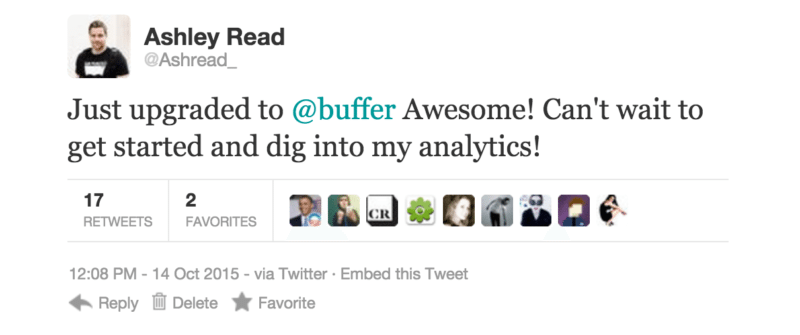
When people make a purchase and share it on social media, this provides and amazing opportunity to make their experience remarkable.
The emotion behind the conversation Excited ?
How to respond
- Express gratitude: Whoa! Someone just became a customer, this is awesome. Try to let them know how grateful you are to have them on board.
- Be open to assist: It could be great to see if there’s any way you can help your new customer get off to a great start. A message along the lines of, “We’re always here if we can help,” may be a brilliant way to re-assure your customer.
How we respond at Buffer: If possible, respond to these ones every time. When someone makes a purchase and shares it on social media this is an amazing opportunity to provide a remarkable customer experience.
17. Courteously responding to a competitor call-out

Consumers can sometimes make their purchasing decisions based on social media responses. When they’re unsure on which product or brand to choose, you sometimes see two (or more) competitors called out against each other.
The emotion behind the conversation: Interested, playful ?
How to respond
- Pick up the conversation: In these situations it can be good to pick up the conversation and reply to the potential customer. A good opener could be something along the lines of, “Hey [Name], how can we help?”
- Don’t talk down the competitor: Focus on your selling points and how you can help the potential customer as opposed to trying to show superiority over your competitor.
- Connect them with sales: If you have a dedicated sales team or sales person then this could be a great opportunity to connect them with this potential customer. You could ask for contact details or pass on the best way to get in touch with your sales team.
How we respond at Buffer: This is an opportunity to win a new customer and a great experience here could win you some new business. If you have the resources, try to respond each time this conversation pops up.
18. Kindly responding to hiring questions

As you grow you may see people inquiring about jobs at your company. Here’s how to reply.
The emotion behind the conversation: Hopeful, curious ?
How to respond
- Say thanks: The fact that anyone is interested in giving up their time to work with your company is amazing it itself. In this situation it’s important to acknowledge that and show your gratitude.
- Point them in the right direction: If you have a jobs board on your site or someone within your team who handles hiring, pointing them potential applicant in the right direction could be a great way to go.
How we respond at Buffer: When someone is interested in working with us, giving them a pointer in the right direction feels great. You could even set up a canned response to speed this up if you receive regular questions on hiring.
19. Swag request from an enthusiastic customer

If you send out swag (tshirts, stickers) to your customers, you’re likely to receive swag requests from customers on social media.
At Buffer we love to show our customers how they mean to us and regularly send hand-written notes, swag and special gifts.
The emotion behind the conversation: Excited ?
How to respond
- Show gratitude: It’s so awesome that people are proud to be associated with your company and want to use your stickers and wear your t-shirts. In reply to swag requests, try to show a little gratitude and let your customers know how amazing they are.
- Point them in the right direction: Some companies have forms where people can request sway, others have slightly different processes. Let your customers know how they can get
How we respond at Buffer: We love to delight our customers and we try to respond to everyone who reaches out about Buffer swag.
20. Admitting a mistake to dismayed customers
Sometimes you will make mistakes. It’ll happen. And occasionally these mistakes will be shared by your customers on social media.
The emotion behind the conversation: Disappointed ?
How to respond
- Accept responsibility: One of the most important things to do here is to take responsibility and show your customers how you’re going to put it right.
- Communicate next steps: How will the mistake be rectified? The way you handle mistakes can huge difference to
How we respond at Buffer: When you’ve made a mistake, it’s probably best to respond to every customer who messages you about it. A swift response can go a long way to rebuilding trust.
21. Graciously receiving feedback

Some customers love to give feedback and this is an amazing opportunity for you to learn more about your product and how customers are using it.
The emotion behind the conversation: Interested, engaged ?
How to respond
- Pass it on: Any feedback could be hugely useful for your product team. Try to pass it on to the relevant team and let the customer know you’re listening.
How we respond at Buffer: If a customer goes out of their way to pass on some feedback, it could be good to always respond where possible.
Three things to remember in any conversation
1. Brand tone and voice
Your brand voice and tone should always be at the forefront of your mind when engaging with people on social media.
Sticking to your brand tone and voice across platforms — from your website and marketing materials, to your customer support and social media channels — helps to provide a consistent experience for the customer.
Your brand will have certain traits that can be identified and recognized by your customers. Your tone should be consistent and align with your company values.
For example, here’s how we handle instructions in customer support emails at Buffer:

You can check out our Buffer Tone Guide here.
2. Platform
The platform can play a big part in how you respond. On Twitter you only have 140 characters to play with, so your replies may need to be a little more concise than on other platforms like Facebook.
Always remain mindful of the platform and how best to respond given the constraints.
3. Be human
The great thing about social media is its ability to humanize business. Where possible try to show some personality in a response — this could mean displaying empathy, vulnerability or simply signing off each message with your name or initials.
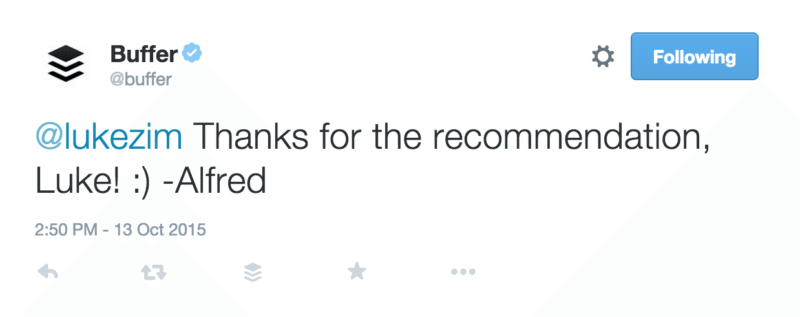
Over to you
Have any other types of conversations popped up on social media for your business?
Any tips you’ like to share on how to respond?
I’d love to learn from you and continue the discussion in the comments.
Try Buffer for free
140,000+ small businesses like yours use Buffer to build their brand on social media every month
Get started nowRelated Articles

If you always feel like you’re chasing the tail-end of audio trends on the app, you’ve come to the right place. In this article, I’ll guide you through all the methods you can use to find the most popular music and sounds on Instagram before they drop off the charts.

All the features on Bluesky, plus how to use them.

I put Meta Verified — and the coveted blue check — under the microscope for two weeks. The results were definitely not what I expected.